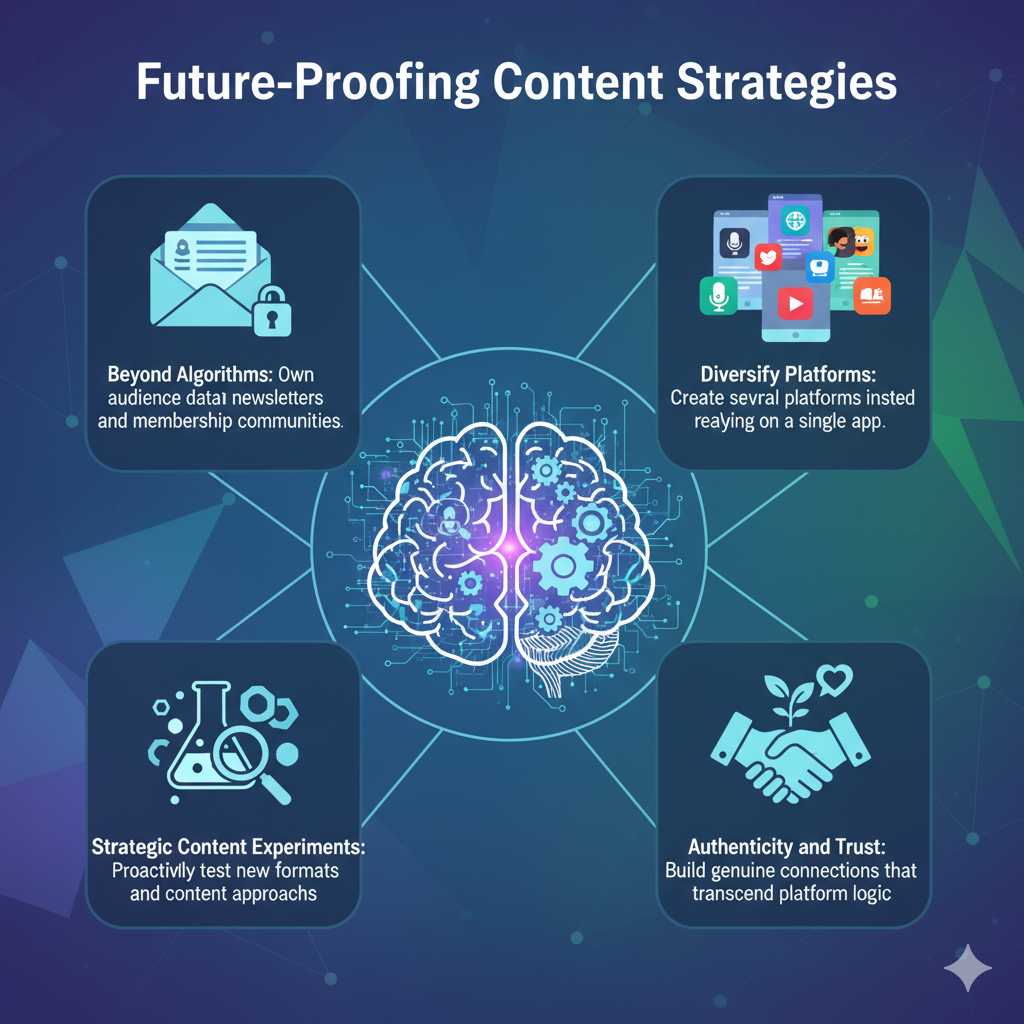
Platform Dependence: What Happens When Social Media Algorithm Changes Turn Against Creators?
One day, you notice that your engagement drops almost 70%. Posts that used to bring in thousands of likes now barely get a hundred. You didn’t change your content; the algorithm did.
Welcome to the era of algorithm chaos, where creators and brands have become entangled in the fluctuations of small code. Few people feel this tension quite like Instagram CEO Adam Mosseri: a man many creators love to hate. His constant adjustments to Instagram’s algorithm, pushing Reels and reordering feed priorities, are altering how millions of creators engage with their audience. Each time there’s an update, anxiety, frustration, and adaptation ripple through the platform.
In our digital economy, one line of code can determine who will thrive, who will disappear, and who will need to start all over again.
From dream platforms to power players
When social media was first launched, it was democratized. Creators could go viral in a night, and small businesses could build empires in their bedrooms. Algorithms were simple: post, post, post, authentically engage, and the audience followed.
Now it is about monetization. The platforms discovered that the absolute power is deciding what people see. And just like that, those algorithms that used to be friendly became gatekeepers.
Instagram wanted Reels. YouTube wanted Shorts. X (formerly Twitter) started to push subscribers. TikTok started testing its “Creativity Program.”
Every single change was “better discovery.” What it meant was a change in who is in view—creating insane pressure for people to be in front of people.
What happens when the rule changes overnight?
Consider the scenario of spending months developing a strategy and then waking up to realize it’s old-fashioned. This is the anxiety of the creator of today.
For instance, we only need to realize how Instagram updated its recommendation algorithm in 2023. It began prioritizing recommendations for what was on the user’s “interest” rather than post order. Out of nowhere, creators that spent years developing loyal communities through steadfast and authentic content were thrown into a cyclone of viral Reels and silly dancing memes.
Or there are the creators of longer-form content who are being—and have been, for that matter—disconnected because YouTube began prioritizing Shorts. Consider the reaction of a creator: “I used to get 100k views per video, and now I’m excited to get 10K. Shorts aren’t my style, but that’s what YouTube wants,” he said on Reddit.
Subscribe to our bi-weekly newsletter
Get the latest trends, insights, and strategies delivered straight to your inbox.
And TikTok’s “For You” feed, which is a wonderful way to discover content, has grown increasingly unpredictable. Just last week, some TikTok users reported having their reach cut by half overnight, and with no explanation.
And it’s not just creators taking notice, but also small businesses, independent journalists, and educators in a community who may rely on reach to sustain visibility.
The silent impact: Platform dependence
Let’s be frank—reliance on platforms. It is what it is.
Creators have developed livelihoods on platforms that they don’t own and are moderated by algorithms that they don’t control. It is harmonious until it isn’t.
Platforms offer capabilities for exposure, monetization, and audience engagement. However, in exchange, creators have become increasingly reliant on algorithms. Their occupation is now reliant on engagement metrics over which they have no control.
When algorithms change, creators feel the tremors first. A 2024 Benchmark Report by Influencer Marketing Hub stated that over 80% of marketers had to adapt their influencer strategies because of platform algorithms.
Frequent algorithm changes create instability that has a direct impact on creators’ reach, visibility, and revenue. To add to that pressure, creators were facing burnout and contemplating quitting. Algorithm updates are not just inconsistent patterns; they are emotional triggers in a field that should cherish consistency and connection.
The mental struggle with the algorithmic rollercoaster
To be frank: this constant algorithmic mayhem is tiring.
Creators are chasing trends they do not stand behind. They post more often, try new things, and watch engagement drop, anyway. And we’re talking burnout.
A 2025 survey by Billion Dollar Boy found that 52% of creators reported experiencing burnout and 37% reported considering quitting altogether, citing algorithmic pressures, consistent income uncertainty, and continual need for more and more content.
It’s not only about engagement, but also about your identity. Creative output for creators is not a hobby – it is their brand, income, and form of art. Therefore, when their algorithms don’t help promote, it feels personal.
Why are the platforms always changing the game
It’s simple to see algorithms as villains, but there’s a rationale for the madness.
Platforms alter their algorithms to maximize engagement and filter spam, all while generating the greatest amount of ad revenue. It is more likely that they will reward new content formats that may serve to implement business objectives. For example, platforms accelerated their promotion of Reels and Shorts to stave off TikTok’s meteoric rise.
The kicker is that every “improvement” has a disadvantage. These platforms prioritize what keeps users scrolling—not what the creator considers beneficial for their post as a means of advancement.
That’s why a video explainer about climate change will be buried, while a trending meme can garner millions of views. Algorithms can’t be bad; they just care about what we would define as amoral.
They don’t care if something is fair or not; they are only concerned with performance.
The creator’s response: Adapt or disappear
So, what does a creator do when the rules keep changing? They adapt. Consistently.
Some creators will pivot formats: long-form YouTubers use Shorts to test other formats; photographers learn video editing to remain relevant on Instagram. Others are diversifying by creating content in multiple places to avoid complete dependence on a particular platform.
We are seeing many creators begin newsletters, podcasts, and personal websites—digital spaces they control. If they can own their audience (which may be via email lists, Discord servers, or subscriptions), they are in a stronger position to deal with algorithm changes in the future.
As one creator puts it, “If the algorithm is a landlord, your own platform is home ownership.”
Case Study: The exodus from Instagram
When Instagram prioritized Reels, engagement dropped significantly for many creators and brands, prompting many to start experimenting with new platforms such as Substack Notes, Lemon8, and Patreon.
The main draw with these platforms was simple: they directly connected the audience to creators, with no algorithm sitting in between.
Take the example of fashion brand Dissh: Dissh is a fashion brand operating in Australia that had to respond to Instagram algorithm updates that limited their organic reach.
Dissh changed its strategy to focus on high-quality, original content that would resonate better with its audience. Dissh also focused on storytelling and leveraging user-generated content, maintaining some level of engagement and brand growth.

This switch in behavior is indicative of something powerful and significant: brands are now reconsidering where they want to spend their creative energy.
Creating a future beyond algorithms
The future of content makers is not anti-algorithm, but algorithm-aware.
The future will be won by creators who remain aware of how algorithms develop but do not become controlled by them. For example:
- Owning audience data through newsletters and membership communities.
- Create several platforms instead of putting all chips on one app.
- Strategically, not reactively, test new formats with content experiments.
- Building authenticity and trust beyond platform logic.

Algorithms may determine what is visible, but authenticity determines what is remembered.
Beyond the algorithm: How brands and creators adapt
Brands and creators are both feeling the aftershocks. Campaigns that were previously working fail overnight after an algorithm change, forcing brands to rely on creator partnerships and owned channels like newsletters or apps.
The latest stars are creators who are algorithm-resilient—creators who look out for broader trends, experiment on multiple platforms, and cultivate a direct connection with their audience. Virality comes and goes, but a community lasts.
The broad lesson is that platforms that develop algorithms are tools, not lifelines. While trending rises with an expected drop-off, owned engagement provides a broader, more dependable audience and growth. Creators and brands are thriving, not just surviving, as they rewrite the algorithm.
Cut to the chase
Algorithms change. Engagement drops. Creators and brands adapt by building direct connections to own their audience. Virality fades, but the community endures. Every platform evolution is an opportunity to rethink your strategy. Don’t wait for the next update—start diversifying your platforms today.


